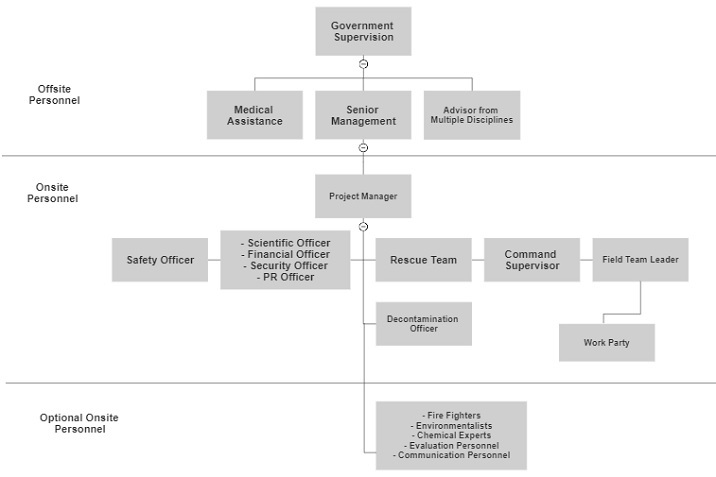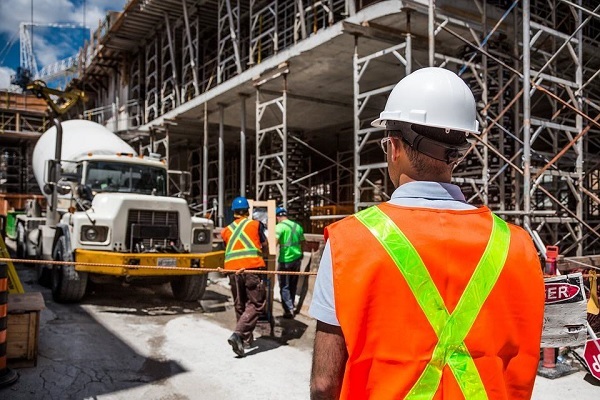
To Plan and To Organise
The first and foremost essential element within a hazardous occupational workplace is the abundance of planning and organisation. The risk within these workplaces can be significantly diminished by anticipating and implementing precautionary measures within the worksite before the commencement of the work. This chapter deals with three aspects of planning, they are −
The development of an organisational structure for the whole sites operation.
Establishment of a comprehensive work plan considering each phase of the operation.
Establishment and implementation of a site safety and work plan.
Planning should be perceived as a perpetual process. Depending on the conditions of the site, the site safety plan must be changed to suit the need at hand. Thus, the primary intention behind this chapter is to lay down a starting point for the activities involved in planning within an occupational setting.
The Structure of Organisation
The structure of the organisation founding the overall objectives of the project must be laid out in the first phase of the planning process. The following conditions must be followed by the structure −
Appoint a leader and make him the authority that directs all the activities.
Appoint all the other human resources required to undertake the project in their respective field of expertise.
Define the lines between responsibility, communication, and authority.
With the progress of the project, some necessary changes must be made to the organisational factors like authorities and individual responsibilities. This is crucial to streamline the performance of individual tasks. In the case of these changes, the changes must be updated across all the documents and must be conveyed to all the parties involved.
The following figure represents an example of a framework an organisation can be based upon. It deals with twenty-four categories of offsite as well as onsite personnel.

In the above illustration, the personnel are categorized on the basis of their responsibilities and roles within the occupational environment. They are also divided into offsite and onsite categories depending on their designation.
We are attempting to comprehend the scope of responsibilities and roles to be covered by this example. In order to design an organisational structure, the above illustration and its categorisation can be used as a skeletal structure or a starting point.
For an organisation of a smaller scale, several of the above functions may be performed by a single person. However, irrespective of the size of an effort, the presence of a site safety and health officer is a must across all response teams. The safety and health officer will be responsible for the implementation of all the health and safety measures.

The Site Safety Officer should easily be able to communicate with all the other occupational safety professionals, specifically with the industrial hygiene specialist.
Upon the successful establishment of the organisational system, all the individuals responsible for its reinforcement should be identified as they must explain the respective job roles to all the safety professionals in the response team.
The attitude of the project managers across all levels of the organisation is another crucial aspect in the field of workplace safety. An ideal project manager must be committed to all the intricate aspects of the workers safety and must prioritise the safety of the workers over the successful completion of the project before the deadlines.
The attitude, in the beginning, sets the nuance for the entire span of the project. The Project Manager and the Site Safety Officer need to be supported by the senior management for the successful establishment and implementation of safety programs.
Several factors within the organisation indicate the successful implementation of worker safety programs. Some of these factors are −
The actions and the involvement of the management in worker safety reflect their strong determination and promise towards worker safety.
Open communications regarding safety and other job-related matters are openly discussed between the workers, managers and supervisors.
The cleanliness within the workplace is well maintained and the workplace is well organised, safeguarded against any airborne contamination.
The organisation has a well-established recruitment process and employee support.
The management does not shy out on applying variations in its safety program to better suit the task at hand.
The management organises certain disciplinary plans to ensure that its employees adhere to the proposed safety practices.
The responsibility of the Offsite Personnel
Although, most of the Offsite personnel belong to the senior management level in the hierarchy. It is the decision taken by them that determines the trajectory of various aspects such as worker safety within an organisation. In fact, every facet of the organisation depends on the decision taken by these individuals.
Let us now learn about major roles and responsibilities related to safety −
Senior Management
The senior management includes the decision-makers of an organisation who set-forth the objectives, requirements, and the structure of the organisation. Their responsibilities include −
Provision of the required facilities, equipment, and financial support.
Provision of human resource and the time required by them to finish the work at hand.
Appreciation of the efforts of the onsite management and work in proper sync with them.
Taking strict disciplinary measures in the case of unsafe work practices.
Advisors from Multiple Disciplines
The advisors are seasoned experts from different fields such as Law, Chemistry, Medicine, Engineering, Industrial Hygiene, Information Technology, Physics and Public Relations. This group of individuals form a crucial part of the upper management as they provide important advice with respect to their field of expertise to lay down the foundation of the safety system within the organisation.

Medical Assistance
This aspect of the management comprises of qualified physicians, nurses, and ambulance personnel. Some of the key responsibilities of the medical assistance include −
Being aware of the kind of materials within the workplace, the risks they pose, and their remedies.
Being always ready for providing emergency treatment that includes decontamination, first aid and other immediate measures that might be required to be taken in case of any serious injuries.
Providing appropriate medical measures for specific kinds of medical emergencies.
Onsite Personnel
The onsite personnel work in the field and look into how the work is carried out in the organisation. For a safety practice to be properly implemented, these employees must be well informed of the safety practices. The employees must adhere to these practices.
Project manager
The project manager controls the daily processes of the workplace from the site itself. Project managers are considered as leaders in the worksite and act as a bridge between the workers and the higher management. Some of their key responsibilities are −
To come up with a review of a situation with respect to the safety plan and the field team.
Getting access to the intricate parts of the site and coordinating the safety-related activities with the higher officials.
Making sure that the work plan is completed on schedule.
Informing all the members of the field team of their individual responsibilities and safety concerns.
Coordinating with the Safety and Health Officer to ensure proper implementation of safety practices.
Making the final report of the overall activities carried out within the site.
Liaising with the Public Affairs Department.
Safety and Health Officer
A Safety and Health Officer assists the Project Manager with necessary advice on common safety practices and their implementation within the site. In the case of any threat to the health of the workers within the site, the safety officer has the privilege to immediately suspend the work until the threat concerned is gone.
The responsibilities of a Health and Safety Officer are as listed below −
- Selecting the appropriate safety outfit and equipment required to undertake a specific task.
Ensuring the hygiene and the proper storage of these outfits and equipment.
Gaining control of every exit at all the access control points..
Coordinating safety activities with assistance from the Scientific Advisor..
Monitoring the workers for various exposures, threats, and contamination.
Checking each workers suitability to work as recommended by the physician.
Advising and implementing new safety plans suitable for the work undertaken.
Monitoring hazards within the site.
Inspecting for the proper enforcement of the Safety Plan.
Establishing a buddy system within the work site.
Being aware of the threats within the worksite and keeping all the necessary contacts in a very close proximity.
Coordinating emergency medical procedures.
Notifying the higher officials in the case of a hazard outbreak.
Field Team Leader
For certain organisations, the field team leader is the same as the Project manager. However, in the case of larger organisations, the field team leader is appointed separately. He may also be a member of the working party. However, the designation of a Field Team Leader varies from organisation to organisation.
The field team leader is responsible for −
- Managing all the operations in the field.
- Executing the plan of the work and setting the schedule for the workers.
- Ensuring the implementation of safety practices within his team.
- Enforcing control over the site.
- Documenting the field activities and collecting samples.
- Liaising with public affairs.
Command Post Supervisor
The Command Post Supervisor establishes communication and provides necessary assistance. Some of his key responsibilities are −
Communicating with the emergency personnel whenever an emergency is raised.
Assisting the Site Safety officer in rescue operations.
Maintaining a record of the site activities.
Maintaining proper communication among the working parties with the help of walkie-talkies, signals and gestures.
Documentation Officer
These officers are responsible for documenting procedures, supplies, and equipment. Some of their key responsibilities include −
Setting up of decontamination lines along with organizing the decontaminantsappropriate to decontaminate specific contaminants.
Supervising over the decontamination of all the equipment and personnel.
Collecting samples from the contaminated areas.
Ensuring the disposal of contaminated clothing.
Making the medical personnel aware of any threat or contamination that they come across.
Rescue Team
The rescue team is always alert to intervene in the case of a rescue situation. Some of their responsibilities are −
- Staying in an alert stance donned with protective clothing in the site.
- Rescuing any endangered worker.
The Working Party
The working party consists of all the team personnel working in the field. The size of the work party may differ from organisation to organisation. However, it must comprise at least two people. Some of the responsibilities of the members of the working party are −
Completion of the task within the time limit while adhering to the safety plan.
Following the Site Safety Plan.
Informing about any unsafe situations to the Site Safety Officer.
Optional Onsite Personnel
The Optional Onsite Personnel are the individuals who are not regularly present on the site, but they pay a visit to the site as and when needed.
Scientific Advisor
The Scientific Advisor guides the Project Manager with respect to the scientific aspects of the project. He provides advice for monitoring of the field, data analysis, sample collection, and much more.
Other Optional Personnel
It is impossible to account for all the personnel that might be having one job role or another in a site within the bounds of this document. However, some other notable types of personnel are −
Logistics Officers − They control the transport of materials to and from the worksite.
Photographers − They capture the conditions within a site for future reference.
Financial/Contracting Officers − They provide financial and contractual support to the site.
Public Information Officers control the transmission of information of the conditions within a site to the public through news and press conferences.
Security officers are responsible for the security of the site from outer interventions.
Recordkeepers maintain records regarding various proceedings of a site.
Bomb-explosion Squad demonstrates the proper use of explosives and helps in the disposal of explosive materials.
Environmentalists help in assessing the environmental factors around the site.
Evacuation Personnel assist in the successful evacuation of a work site in the case of an emergency.
Firefighters are invoked in the case of a fire outburst at the work site.
Health Physicists evaluate the radiation level within the site.
Industrial Hygienists asses the overall health of the employees and advice proper health practices.
Toxicologists assess the toxicity of various substances present in the site.